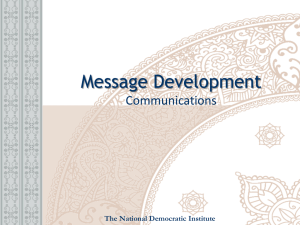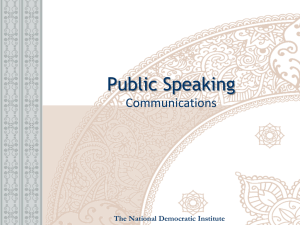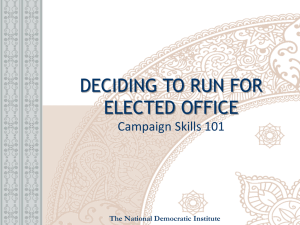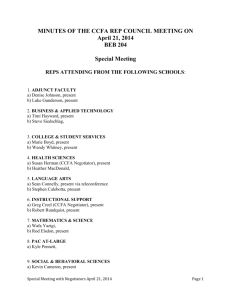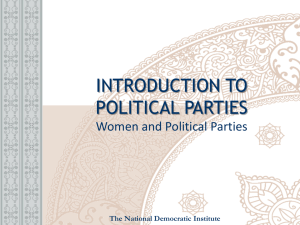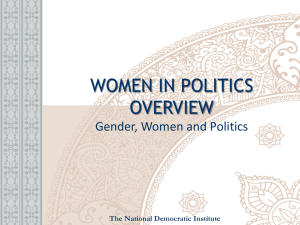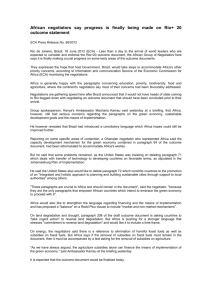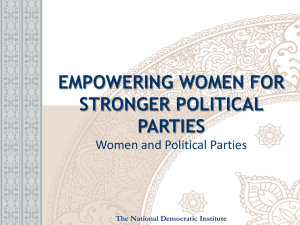TMI Draft1-1 - University of Southern California
advertisement
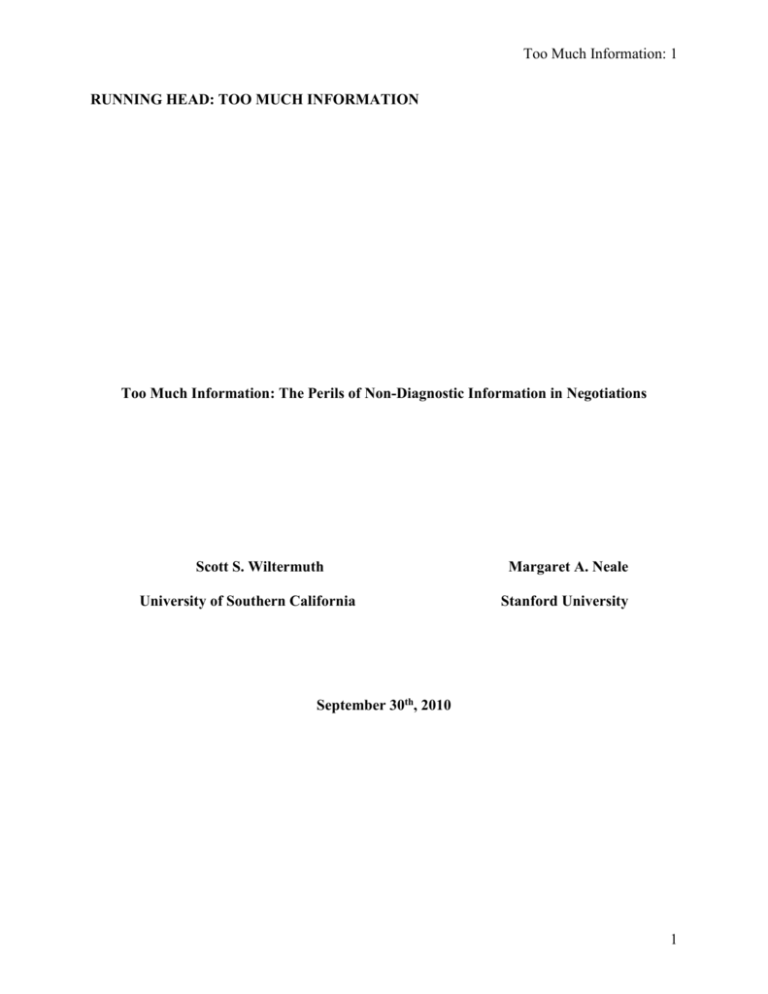
Too Much Information: 1 RUNNING HEAD: TOO MUCH INFORMATION Too Much Information: The Perils of Non-Diagnostic Information in Negotiations Scott S. Wiltermuth University of Southern California Margaret A. Neale Stanford University September 30th, 2010 1 Too Much Information: 2 Abstract Two studies showed that possessing information about a negotiation counterpart that is irrelevant to the negotiation task can impair negotiators’ effectiveness because such knowledge impedes effective information exchange. In Study 1 negotiators who possessed diagnostic and nondiagnostic forms of information were each less likely to exchange information about their preferences within the negotiation. However, only those negotiators who possessed nondiagnostic information achieved inferior negotiation outcomes as a result. In Study 2 negotiators possessing non-diagnostic information about their counterparts in electronically mediated negotiations were more likely to terminate the search for mutually beneficial outcomes prematurely and declare impasses. They were also less able to use diagnostic forms of information to make mutually beneficial trade-offs. As a result, negotiators in these dyads achieved inferior outcomes. 2 Too Much Information: 3 Too Much Information: The Adverse Impact of Non-Diagnostic Information in Negotiations Negotiators often seek out information about their counterparts to give themselves an edge, as the ability to understand the preferences, strategies, goals, and interests of negotiation counterparts represents one of the core cognitive competencies necessary for success in negotiations (Carroll, Bazerman, & Maury, 1988). Negotiators who understand their counterparts may be better able to predict counterparts’ behaviors (Bazerman & Carroll, 1987; Lax & Sebenius, 1992). They may also be more open and forthright with their counterparts (Drolet & Morris, 2000; Moore, Kurtzberg, Thompson, & Morris, 1999; Morris, Nadler, Kurtzberg, & Thompson, 2002) and therefore better able to identify the opportunities available for value creation (Brodt, 1994; Thompson and Hastie, 1990). However, not all information about counterparts is equally useful within negotiations. For example, information about a counterpart’s comfort with change may have little value in predicting counterparts’ negotiating behavior. While such pseudorelevant information (Hilton & Fein, 1989) may not be useful in a negotation context, it may nonetheless appear useful to negotiators and therefore affect their behavior. We examine whether possessing non-diagnostic information (NDI) can impair negotiation performance by reducing negotiators’ willingness to engage in the information exchange necessary to create and claim value. In doing so, we look to set boundaries on the assumption that information is helpful (or at least not harmful) within negotiations (e.g., Latz, 2004; Lewicki, Saunders, & Minton, 1997). We also provide a counterpoint to previous findings showing that possessing information about a counterpart can bolster negotiation effectiveness through the mechanisms of improved rapport and trust (Drolet & Morris, 2000; Moore, Kurtzberg, Thompson, & Morris, 1999). We also seek to extend our understanding of the 3 Too Much Information: 4 dilution effect (Nisbett, Zukier, & Lemley, 1981) by showing that NDI can lead people to truncate information exchange in competitive social interactions. Finally, we examine how power may affect the impact of NDI. Non-Diagnostic Information Prior research indicates that decision makers often fail to differentiate diagnostic information (DI), which is predictive of outcomes or behavior in a given domain, from nondiagnostic information (NDI), which is not predictive of outcomes or behavior in that domain (e.g., Peters & Rothbart, 2000; Zukier, 1982). NDI often reduces the degree to which decisionmakers utilize DI (Nisbett et al., 1981) and can impair the quality of their decisions in consumer purchases (Meyvis & Janiszewski, 2002), auditing judgments (Glover, 1997; Hackenbrack, 1992; Hoffman & Patton, 1997; Waller & Zimbelman, 2003), hiring decisions (Highhouse, 1997), and jury decision making (Fein, McCloskey, & Tomlinson, 1997). NDI has also been shown to create overconfidence in a host of tasks ranging from the prediction of basketball games (e.g., Tsai, Clayman, & Hastie, 2008) to performance in economic games in which no social interaction takes place (e.g., De Dreu, Yzerbyt, & Leyens, 1995). While NDI has not been shown to affect behavior in social tasks, cognitive negotiation theory (Neale and Bazerman, 1991) would suggest that NDI may also influence how people share information in competitive interactions. Consistent with this theory, negotiators who assess that they have the necessary information to achieve their goals may be less motivated to seek task-relevant information from their counterpart (Bazerman & Carroll, 1987; Einhorn & Hogarth, 1978; Neale & Bazerman, 1985) and more hesitant to reveal information about their own preferences if they believe the information that they possess has competitive utility (Gerarda Brown & Ayres, 1994; Lax and 4 Too Much Information: 5 Sebenius, 1992). Negotiators who possess DI would also curtail information exchange for these same reasons but they would have a genuine informational advantage to protect. We offer: Hypothesis 1: Negotiators who possess non-diagnostic information or diagnostic information about their counterparts will exchange less information relevant to the negotiation than will those without such non-diagnostic information. Negotiators who possess information about their counterparts may also be less likely to attend to the diagnostic information that is exchanged (Nisbett et al., 1981). If negotiators possessing NDI do exchange less diagnostic information or pay less attention to the diagnostic information that is exchanged, they should be less likely to discover the mutually beneficial trades that create value and less likely to identify opportunities to claim value (Neale & Bazerman, 1985; 1991; Pruitt, 1981). With this logic in mind, we assert: Hypothesis 2a: Negotiators possessing non-diagnostic information accrue less value in their negotiations than do those without such information. Hypothesis 2b: Dyads in which a negotiator possesses non-diagnostic information create less value than do dyads in which neither negotiator possesses non-diagnostic information. All negotiators may not be equally susceptible to the effects of NDI. Negotiators who are in powerful states of mind (Galinsky, Gruenfeld, & Magee, 2003) are more susceptible to overconfidence (Anderson & Galinsky, 2006), ask fewer diagnostic questions about their counterparts’ interests and positions (Van Kleef, De Dreu, & Manstead, 2004), and are less motivated to maintain accurate perceptions of others (Fiske, 1993; Fiske & Depret, 1996; Galinsky et al., 2003). Indeed, high-power negotiators are particularly likely to rely on incomplete knowledge and unfounded presumptions about their negotiating partners (De Dreu & Van Kleef, 2004; Galinsky et al., 2003). We therefore hypothesize: 5 Too Much Information: 6 Hypothesis 3: Possessing non-diagnostic information reduces individual negotiator outcomes more severely when possessed by negotiators entering negotiations in powerful mindsets than if possessed by negotiators entering the negotiation in powerless mindsets. In addition to testing whether NDI impairs negotiation performance by instilling feelings of advantage and abbreviating information exchange, we also tested whether NDI about the counterpart impaired performance by increasing negotiators’ liking of, or feelings of similarity with, their counterparts. If so, possessing NDI may lead negotiators to negotiate less aggressively and therefore achieve inferior outcomes. We conduct a pre-test and two experiments to test our ideas. The pre-test establishes that both DI and NDI can lead negotiators to feel they possess an advantage in negotiations. Experiment 1 examines how possessing both DI and NDI affect negotiation outcomes in a face-to-face negotiation exercise. Experiment 2 tests whether NDI can have pernicious effects in electronically-mediated negotiations. We examined which behaviors accounted for the relationship between NDI and impaired negotiation performance, as we wanted both to understand the psychology involved and to provide clear prescriptions for negotiators wishing to avoid the perils of NDI. In focusing on behavioral mediators, we follow the lead of numerous negotiation researchers (e.g, Sinaceur, 2010; Kopelman, Rosette, & Thompson, 2006). Pre-Test We administered a pre-test to determine whether DI and NDI could lead negotiators to feel they have an advantage. Sixty students at a West Coast University (47% female; Mage = 21) received $8 to participate in a negotiation study. They began the study by completing the Keirsey Temperament Sorter (Keirsey, 1978) and subsequently conversing with their counterpart for five minutes. Participants then read the instructions for a multi-issue negotiation. In one-third of the cases they also received DI, which stated the importance the counterpart placed on various 6 Too Much Information: 7 issues. In one-third of the cases they received NDI, which was “Barnum Effect” information ostensibly based on their counterparts’ responses to the Keirsey Temperament Sorter. In onethird of the cases they received no information. Both the NDI and DI are listed in Appendix 2. Participants receiving information were told, “In this study one participant is randomly chosen to receive person-specific information about the other participant. You have been chosen to receive this information. Please read this information but please do not refer to this information in any way during the negotiation. The other party will not receive this information nor will s/he receive person-specific information about you. Again, please do not refer to this information during the negotiation.” Participants were then given a distracting task lasting five minutes. Participants used a seven-point Likert scale to answer: “How much do you think you have an informational advantage relative to your counterpart?”, “How sure are you that you will be able to control the negotiation in your favor?”, “How favorable do you think the final agreement will be to you?”, “How confident are you that you have information about your counterpart that can help you predict how he/she will behave?”, “Based on what you know about your counterpart, how much of an advantage do you think you have in this negotiation?”. They concluded the experiment by indicating feelings of similarity, liking, and trust toward the counterpart. We combined participants’ responses to the questions addressing feelings of advantage into a single index (α = .78). Feelings of advantage were uncorrelated with counterpart’s feelings of advantage (r = .00, p > .95), so we analyzed the data at the individual level. We then conducted 1 x 3 information (no information vs. NDI vs. DI) ANOVAs examining the effect of information on feelings of advantage, trust, similarity, and liking. The overall F-statistic for feelings of advantage was significant, F(2,57) = 3.34, p = .04. As predicted, negotiators receiving NDI felt as though they possessed an advantage (M = 4.76, SD = 1.13) relative to negotiators in 7 Too Much Information: 8 the control condition (M = 4.03, SD = 1.16), t(57) =2.20, p = .03, d = .63. The same was true for negotiators possessing DI (M = 4.79, SD = 0.81), t(57) =2.28, p = .03, d = .76. We also tested whether NDI could affect negotiators’ concern for their counterparts either positively or negatively; however, measures of trust, liking, and similarity were not affected by condition, all p’s >.15. Experiment 1 In Experiment 1 we explored whether negotiators with NDI and DI exchanged less information with their counterparts. We also explored whether the reduced information exchange impaired negotiation outcomes for negotiators possessing NDI. Method Participants and Experimental Design. A total of 154 students (54% female; Mage = 21) participated in the negotiation exercise for $12. We crossed negotiator role instructions with power (high power vs. low power). There were three types of dyads: dyads in which one negotiator possessed NDI about the counterpart; dyads in which one negotiator possessed DI about the counterpart’s interests; and dyads in which neither negotiator possessed the NDI or DI. We varied whether the high-power or the low-power negotiator possessed the information. Procedure After completing the Keirsey Temperament Sorter, participants were asked to recall a time in their life when they felt either powerful or powerless. They wrote about that time in concrete detail for ten minutes. This power manipulation has been shown to produce effects similar to those created by structural or role-based manipulations of power (e.g, Magee, Galinsky, & Gruenfeld, 2007). We then distributed NDI or DI to some participants. Subsequently, participants completed the negotiation exercise and filled out a post-negotiation questionnaire. 8 Too Much Information: 9 The Negotiation Task. Participants participated in a two-party, six issue negotiation exercise that was adapted from the “New Recruit Exercise” (Pinkley, Neale, & Bennett, 1994) to reduce power differentials between roles. In this exercise both negotiators played the role of company representatives who were tasked with merging their respective companies. The negotiators were given a description of the negotiation, a pay-off matrix, and a message stating the number of points they would attain should they fail to reach an agreement. Four of the issues were integrative, one was distributive, and one was congruent. Information Manipulation. Participants were randomly assigned to receive the DI, the NDI, or no information. The forms of DI and NDI were those used in the pre-test and listed in Appendix 2. Dependent Variables. Individual and joint points were the primary dependent variables. Participants also indicated how much each negotiator in a dyad revealed information about his/her preferences for different outcomes and how much they trusted, liked, and felt similar to their counterparts. They also ranked all issues in order of decreasing importance from the perspective of the counterpart and from their own perspective. Results Treatment of Data. All dyads reached agreements. Members of six dyads expressed suspicion about the NDI manipulation and were excluded from the analysis. Two dyads were excluded for their failure to follow the negotiation instructions. Excluding these eight dyads did not significantly affect results. Because neither negotiator role nor the interaction terms of negotiator role x NDI (p= .51) nor the interaction term of negotiator role x DI (p = .48) had a significant effect on negotiator points, roles were combined in all analyses. We analyzed individual-level data using hierarchical linear modeling (Raudenbush & Bryk, 2002). 9 Too Much Information: 10 Manipulation Check. Two coders (inter-rater α = .77), blind to condition, coded on a seven-point Likert scale how much power participants expressed in their essays. Participants possessed more power in the high-power than in the low-power essays (M = 3.61, SD = 1.64 vs. M = 1.34, SD = 0.67), t(36) = 6.77, p < .001, d = 1.81. Individual-Level Outcomes Table 1 displays correlations between all variables. Consistent with Hypothesis 1, negotiators were rated by their counterparts as revealing significantly less information about their preferences when they (M = 4.50, SD = 1.59) or their counterparts possessed NDI (M = 4.49, SD = 1.44) than were negotiators in the control condition (M = 5.37, SD = 1.03). Negotiators possessing DI (M = 4.67, SD = 1.58) and those facing counterparts possessing DI (M = 4.67, SD = 1.35) shared less information than did those in the control condition. Results may be seen in Model 1 of Table 2. Condition did not affect self-ratings of information revelation. Model 2 of Table 2 displays further support for Hypothesis 1. Negotiators possessing NDI and their counterparts were each less accurate than negotiators in the control condition in identifying their respective counterparts’ two least important issues at the negotiation’s end. Those with NDI correctly identified the counterpart’s two least important issues 14% of the time, whereas those who had neither NDI nor DI correctly identified the counterpart’s two least important issues 26% of the time. Neither NDI nor DI affected negotiators’ ability to identify the two issues most important to their counterparts nor did DI affect the accuracy in identifying the two least important issues. As shown in Table 3 and consistent with Hypothesis 2a, negotiators’ outcomes were impaired when they possessed NDI. Possessing DI did not impair negotiators’ outcomes. However, DI had a marginally significant negative effect on counterparts’ outcomes. Table 3 10 Too Much Information: 11 displays the mean points by condition. Table 3 also reveals that primed power, the interaction of primed power and NDI, and the interaction of primed power and DI did not significantly influence negotiator outcomes. Hypothesis 3 therefore did not receive support. Reduced information exchange partially mediated the relationship between possessing NDI and impaired negotiation outcomes. Relative to negotiators in the control condition, negotiators possessing NDI revealed less information about preferences for different outcomes during the negotiation, ß = -.31, z = -2.53, p = .01. Revealing information was associated with higher points claimed, ß = .34, z = 2.80, p = .01. When we controlled for the amount of information exchanged, the effect of NDI on negotiator points remained significant, ß = -.24, z = -2.00 p = .05. The test of mediation was significant, z’ = -1.97, p < .01 (see MacKinnon, Lockwood, Hoffman, West, and Sheets, 2002). We tested the possible alternative explanations that possessing NDI impaired negotiator outcomes by instilling liking, trust, or feelings of similarity with the counterpart. As possessing NDI did not significantly affect any of these variables (all p’s > .10), these variables did not mediate the relationship between NDI and impaired negotiation performance. Dyadic-Level Outcomes. As predicted in Hypothesis 2b, dyads in which a negotiator possessed NDI created significantly less value than did control condition dyads, t(45) = 2.11, p = .04, d = .68. Reduced information exchange accounted for the reduction in total points created in dyads in which one party possessed NDI. As Figure 1 illustrates, adding the counterpart-generated rating of revealed information to the equation regressing total points on non-diagnostic information reduced the effect of NDI to non-significance. The test of mediation was significant, z’ =1.77, p < .01. DI did not significantly affect value creation. Discussion 11 Too Much Information: 12 Negotiators possessing NDI about a counterpart were less successful in exchanging taskrelated information and achieved inferior negotiation outcomes. Suggesting that asymmetric information interfered with the exchange of more useful forms of information, negotiators possessing NDI less accurately identified the counterparts’ least important issues at the negotiations’ conclusions. We did not find support for our hypothesis that value claiming would be most reduced for high-power negotiators who received NDI. Experiment 2 Experiment 2 further examines how NDI affects negotiation behavior and outcomes. Extending Neale and Bazerman’s (1991) emphasis on cognitive processing and information exchange, we examine the impact of NDI in an electronically-mediated negotiation. Using this format allows us to understand more fully how NDI affects information exchange and processing within negotiations. It also allows us to examine whether negotiators with NDI make smaller concessions, fewer concessions, or concessions that create less value. In Experiment 2 we also examine whether NDI increases the rate of impasses, as may be the case if NDI instills a sense of advantage. We also examine whether the reduced information exchange seen in Experiment 1 resulted from the instructions prohibiting participants from referring to the NDI. Further, we include new measures to assess whether NDI heightened negotiators’ expectations of their own performance and we include a condition in which both negotiators possessed NDI. Finally, we manipulate power instead of priming it. Method Participants and Experimental Design. A total of 140 (64% female; Mage = 31) participants from a web-based participant pool completed the exercise for a $13 gift certificate and the chance to win a $99 gift certificate. Their odds of winning were based on their negotiation performance. 12 Too Much Information: 13 The experimental design of the study included the mixed-dyad variables of high-power and lowpower possession of NDI about the counterpart (possess vs. not possess); the within-dyad variables of role (Tolliver Company Representative vs. Radeco Company Representative) and power (high power vs. low power); and the between-dyad variable of instructions not to refer to the NDI (instructions not to refer vs. no instructions). Procedure. Participants completed the Keirsey Temperament Sorter and received a link to their negotiation instructions. Half of the negotiators were given the same NDI about their counterparts as was used in Experiment 1. In half of those cases, we omitted the instructions about confidentiality. A questionnaire asked negotiators to provide the content of their initial email message and why they wanted to begin negotiations in that way. We emailed the contents of their messages to their counterparts and told negotiators that they could continue negotiations by sending an e-mail to a university mailbox. We sent negotiators a post-negotiation questionnaire after they had reached an agreement or an impasse. Negotiation Task. Participants engaged in the same negotiation exercise used in Experiment 1. We manipulated power within the negotiation instructions using a technique described by Overbeck, Neale, and Govan (2010). Specifically, we told participants in the high-power position “you are in a very strong negotiating position and can afford to use your leverage to get a good deal,” and we told participants in the low-power position “you are in a very weak negotiating position and do not have much leverage to get a good deal.” Participants were told the number of points they would attain should they fail to reach an agreement. Dependent Variables Points claimed by the individual negotiator and by the dyad and the rate of impasses served as the primary dependent variables. We also collected measures of liking, similarity, and 13 Too Much Information: 14 trust of the counterpart. Negotiators also indicated how many points they expected to accumulate. We administered a post-negotiation questionnaire that included many of the questions found in the questionnaire used in Experiment 1. We counted the number of messages negotiators sent and the number of words the negotiators used in those messages. We had two independent raters who were blind to hypotheses and conditions code whether negotiators expressed their prioritization of different issues in those messages. We examined whether negotiators with NDI would be less attentive to information revealed by their counterparts and would make concessions that created less value than those made by negotiators without such information. To calculate the value-creation associated with a concession we subtracted the points the negotiator making the concession would lose relative to his/her previous offer from the points the counterpart would gain from the offer relative to the previous offer. By asking negotiators to convey their initial positions on all six issues prior to beginning the negotiation, we were able to compute the size of concessions even if the negotiator message mentioned only one or two issues. We also examined the size and the number of concessions. Results Treatment of Data. Neither the effect of the role nor the interaction term of role x NDI was significant, p’s > .8. We therefore combined roles in all subsequent analyses. Receiving instructions to keep NDI confidential did not affect negotiator outcomes, p > .6; we therefore also pooled results from these conditions. Eight dyads, distributed across conditions, were excluded from the analysis because of one member’s failure to follow the negotiation instructions. Excluding these dyads did not significantly affect results. 14 Too Much Information: 15 Expectations Entering the Negotiation. A 2 (high power position vs. low power position) x 2 (NDI vs. no NDI) ANOVA revealed significant main effects for power and NDI on expected outcomes. Negotiators in the high power position expected to accumulate more points (M = 5,877, SD = 2,425) than did those in the low power position (M = 4,787, SD = 1,831), F(1,135) = 5.25, p = .02, d = .51. Negotiators given NDI expected to accumulate more points (M = 5,710, SD = 2,414) than did those not given NDI (M = 4,941, SD = 1,917), F(1,135) = 9.87, p = .01, d = .35. The interaction between NDI and power was not significant, p > .8. A logistic regression revealed negotiators with NDI were significantly more likely to report a perception of advantage entering the negotiation (M = 35% vs. M = 22%, B = .78, SE = .40, Wald = 3.76, p = .05, Exp(B) = 2.17). Power also had a significant positive effect, p < .05 on perceptions of advantage. NDI and Unsuccessful Information Exchange Table 4 displays correlations between all variables. As Table 5 reveals, negotiators possessing NDI were not reported by their counterparts as less revealing of information about their preferences for different outcomes than were negotiators without such information. They were also no less knowledgeable about their counterparts’ priorities at the negotiation’s conclusion, p > .5. Further, the number or length of messages sent between negotiators did not vary across condition, p’s > .10. Coders’ ratings (inter-rater α = .81) indicated that they also did not make fewer (or more) statements about their prioritization of issues within those messages, p’s > .2. We therefore found no evidence that NDI curbed information sharing. However, the results suggested that negotiators with NDI were less attentive to information about counterparts’ interests and preferences for different outcomes and less effective at capitalizing on differences in negotiator priorities. Each concession made by negotiators possessing NDI created 189 (SD = 953) points in value, whereas each concession 15 Too Much Information: 16 made by negotiators not possessing such information created 483 (SD = 755) points in value, t(129)=1.95, p = .05, d = .34. The concessions made by negotiators without NDI did not yield the counterpart significantly more points (M = 1,540, SD = 1,433 vs. M = 1,610, SD = 1,566; t(127) = 0.28, p = .78, d = .04) or cost conceding negotiator significantly fewer points (M = 1,051, SD = 1,367 vs. M = 1,430, SD = 1,442; t(127) = 1.549, p = .12, d = .27) than did concessions made by negotiators possessing NDI. However, the difference between gain and the sacrifice was significantly greater (and more positive) for negotiators who did not possess NDI. Model 2 of Table 5 displays this effect. Individual Outcomes Consistent with Hypothesis 2a and shown in Table 5, negotiators’ outcomes were significantly impaired when they possessed NDI. Table 6 displays the negotiators’ mean points by condition. Mediation analysis suggests that negotiators with NDI accumulated less value due to their inability to use information about their counterparts’ interests and preferences for different outcomes to make value-creating concessions. Receiving NDI led negotiators to make concessions that created less value, ß = -.17 z = -1.97, p = .05. Making value-creating concessions was associated with higher points claimed, ß = .32, z = 3.76, p < .001. Including this measure of value creation in concessions reduced the previously significant effect of possessing NDI on points claimed (ß = -.18, z = 2.08, p = .04) to non-significance (ß = -.15, z = 1.81, p = .07). The test of mediation was significant, z’ = -1.73, p < .01 (MacKinnon et al., 2002). In Hypothesis 3 we predicted that possessing NDI would be particularly harmful for powerful negotiators. Although the Power x NDI interaction did not reach significance, more specific planned contrasts recommended by Rosnow and Rosenthal (1989) revealed that highpower negotiators claimed significantly fewer points when they possessed NDI (M = 3,073, SD = 16 Too Much Information: 17 1,192 vs. M = 3,733, SD = 1,475; t(67) = 2.04, p = .05, d = .49),while low-power negotiators did not accumulate significantly fewer points, p = .47. Trust, similarity, and liking of the counterpart did not independently explain the impaired performance of negotiators possessing NDI. Dyadic Outcomes. Consistent with Hypothesis 2b, negotiators in dyads in which at least one negotiator possessed NDI created less value (M = 6,088, SD = 1,610) than did dyads in the control condition (M = 7,271, SD = 1,216), t(65) = 2.81, p = .01, d = .84. Dyads in which both parties possessed NDI created significantly less value (M = 5,989, SD = 1,700) than did dyads in the control condition, t(65)=2.34, p = .02, d = .87. A significantly higher rate of impasses in dyads in which at least one negotiator possessed NDI (χ2(1) = 5.7, p = .02) contributed to the difference in value creation across conditions.1 When neither negotiator possessed NDI, no dyads reached impasses. When one negotiator possessed NDI the dyads reached impasses in 10 of 34 dyads, and when both negotiators possessed NDI the dyads reached impasses in 5 of 18 dyads. Discussion Negotiators with NDI achieved inferior outcomes and were significantly more likely to reach impasses in these electronically-mediated negotiations – a sign that they were not exchanging information about preferences in ways that allowed them to discover mutually beneficial agreements. While negotiators with NDI did not transmit different amounts of information about their preferences in this electronically-mediated negotiation than did those without NDI, negotiators with NDI seemed less able to use the information that was transmitted. Thus, NDI may impair how effectively negotiators incorporate more diagnostic information. 1 When we excluded the results of negotiations ending in impasses, dyads in which at least one negotiator possessed NDI generated non-significantly fewer points (M = 6,710, SD = 1,449) than did dyads in which neither negotiator possessed NDI (M = 7,271, SD = 1,216), t(51)=1.44 p = .16, d = .42. Thus, the difference was no longer significant when we excluded impasses. 17 Too Much Information: 18 This distinction would not have been easily discovered in the Experiment 1’s face-to-face negotiation, as negotiators themselves may not have been aware of this distinction. General Discussion Although negotiators are often encouraged to learn as much as they can about their counterparts to gain informational advantages (Neale & Bazerman, 1991), the effects of attending to different forms of information about the counterpart on negotiator performance have not been previously explored. In our studies possessing NDI about a counterpart impaired negotiator effectiveness in both face-to-face and electronically-mediated negotiations. Because NDI interferes with the exchange of more diagnostic information, negotiators with NDI are less able to reach mutually-beneficial solutions and accumulate value for themselves. Negotiators with NDI were also more likely to reach impasses in electronically mediated negotiations. In Experiment 1 negotiators possessing NDI were, at the negotiation’s conclusion, less accurate in identifying the counterpart’s least important issues – and it is these issues that may be the key to proposals that maximize value creation. So while NDI did not crowd out all information, our results do suggest that NDI can influence negotiators’ abilities to see the nuanced opportunities for value creation presented by asymmetric interests. NDI also had a detrimental effect on information exchange and negotiation outcomes in electronically-mediated negotiations. Negotiators given NDI reached more impasses and were less able to make value-enhancing concessions than were negotiators not possessing NDI. We did not find full support across our studies for the idea that negotiators in positions of power are more vulnerable to the perils of possessing NDI. Specifically, in Experiment 1 we found no evidence that power moderated the effect of NDI. While the results of Experiment 2 indicated that it was only negotiators in positions of high power whose outcomes were 18 Too Much Information: 19 significantly impaired by possessing NDI, it is clear that more research on the interaction of power and information is needed. For example, research could explore how the basis of one’s power (French & Raven, 1959) affects how attentive an individual is to different forms of information, as expert and coercive forms of power might have dramatically different effects. This paper extends Neale and Bazerman’s (1985) finding that overconfident negotiators create less integrative outcomes by suggesting that possessing irrelevant information may cause illusory perceptions of knowledge that may impair negotiators’ performances. It also furthers our understanding of how NDI can influence strategic behavior. While previous research on the dilution effect has proven that NDI can crowd out DI (Nisbett et al., 1981; Zukier, 1982), our studies are unique in demonstrating that pseudorelevant information (Hilton & Fein, 1989) can inhibit information exchange in competitive social interactions. Moreover, the studies suggest that negotiators should critically evaluate how well they know the preferences and tendencies of their counterparts, especially if they possess potentially extraneous information about them. A limitation of the current studies is that the DI had more of a task-specific component to it than did the NDI. Future studies could productively explore how diagnostic information about the counterpart’s personality affects negotiator behavior. In summary, we have found that possessing non-diagnostic information can lead negotiators to create and claim less value, and that it is the inattention to more diagnostic forms of information resulting from the possession of NDI that drives the impairment in performance. As a result, we caution negotiators against indiscriminately attending to all forms of information about their counterparts. As the old adage goes, a little knowledge is a dangerous thing. 19 Too Much Information: 20 Acknowledgements: The authors would like to thank Jing Zhou, Jared Curhan, and two anonymous reviewers for their thoughtful comments on earlier versions of this manuscript. 20 Too Much Information: 21 References Anderson, C., & Galinsky, A. D. (2006). Power, optimism, and risk-taking. European Journal of Social Psychology, 36, 511-536. Bazerman, M.H. and Carroll J.S. (1987), Negotiator cognition. In B. Staw and L.L. Cummings (eds.), Research in organizational behavior (Vol. 9, pp. 247-248). Greenwich, CT: JAI Press. Brodt, S.E. (1994). “Inside information” and negotiator decision behavior. Organizational Behavior and Human Decision Processes, 58 (2), p. 172-202. Carroll, J. S., Bazerman, M. H., & Maury, R. (1988). Negotiator cognitions: A descriptive approach to negotiators' understanding of their opponents. Organizational Behavior and Human Decision Processes, 41, 352-370. De Dreu, C.K.W. & Van Kleef, G.A. (2004). The influence of power on the information search, impression formation, and demands in negotiation. Journal of Experimental Social Psychology, 40, 303-319. de Dreu, C. K. W., Yzerbyt, V. Y., & Leyens, J-P. (1995). Dilution of stereotype-based cooperation in mixed-motive interdepence. Journal of Experimental Social Psychology, 31, 575593. Drolet, A. L., & Morris, M.W. (2000). Rapport in Conflict Resolution: Accounting for how faceto-face contact fosters mutual cooperation in mixed-motive conflicts. Journal of Experimental Social Psychology, 26, 26-50. 21 Too Much Information: 22 Einhorn H., & Hogarth, R. (1978). Confidence in judgment: Persistence in the illusion of validity. Psychological Review, 85, 395-416. Fein, S., McCloskey, A. M. & Tomlinson, T. M. (1997). Can the jury disregard that information? The use of suspicion to reduce the prejudicial effects of pretrial publicity. Personality & Social Psychology Bulletin, 23, 1215-1226. Festinger, L. (1957). A theory of cognitive dissonance. Stanford, CA: Stanford University Press. Fiske, S.T. (1993). Controlling other people: The impact of power on stereotyping. American Psychologist, 48, 621-628. Fiske, S.T. & Dépret, E. (1996). Control, interdependence, and power. Understanding social cognition in its social context. In W. Stroebee and M. Hewstone. (Eds.), European review of social psychology Vol. 7, pp. 31-61). Chichester, UK: Wiley. French, J. R. P., Raven, B. The bases of social power. In D. Cartwright and A. Zander (Eds.), Group dynamics. New York: Harper & Row, 1959. Galinsky, A.D., Gruenfeld, D.H., & Magee, J.C. (2003). From power to action. Journal of Social and Personality Psychology, 85 (3), 453-466. Gerarda Brown, J. & Ayres, I. (1994). Economic Rationales for Mediation, 80 VA. L. REV. 323, 339–40. Glover, S. M. (1997). The influence of time pressure and accountability on auditors' processing of nondiagnostic information. Journal of Accounting Research, 35, 213-226. 22 Too Much Information: 23 Hackenbrack, K. (1992). Implications of seemingly irrelevant evidence in audit judgments. Journal of Accounting Research, 30, 126-136. Highhouse, S. (1997). Understanding and improving job-finalist choice: the relevance of behavioral research. Human Resource Management Review, 7: 449-470. Hilton, J. L. and Fein, S. (1989). “The Role of Typical Diagnosticity in Stereotype-Based Judgments.” Journal of Personality and Social Psychology 57(2), 201-11. Hoffman, V. B., & Patton, J. M. (1997). Accountability, the dilution effect, and conservatism in auditors’ fraud judgments. Journal of Accounting Research, 35, 227–238. Keirsey, David (1978). Please Understand Me II: Temperament, Character, Intelligence (1st Ed. ed.). Prometheus Nemesis Book Co. ISBN 1885705026. Kopelman, S., Rosette, A., and Thompson, L. (2006). The three faces of eve: Strategic displays of positive neutral and negative emotions in negotiations. Organization Behavior and Human Decision Processes, 99 (1), 81-101. Lax, D. & Sebenius, J. (1992). The Manager as Negotiator: The Negotiator's Dilemma: Creating and Claiming Value. Dispute Resolution, 2nd ed., Stephen Goldberg, Frank Sander and Nancy Rogers (Eds.). Boston: Little Brown and Co., 49-62. Lewicki, R.J., Saunders, D.M., & Minton, J.W. (1997). Essentials of negotiation. Chicago, IL: Irwin. 23 Too Much Information: 24 MacKinnon, D.P., Lockwood, C.M., Hoffman, J.M., West, S.G., & Sheets, V. (2002). A comparison of methods to test mediation and other intervening variable effects. Psychological Methods, 7, 83-104. Magee, J. C., Galinsky, A. D., & Gruenfeld, D. H. (2007). Power, propensity to negotiate, and moving first in competitive interactions. Personality and Social Psychology Bulletin, 33, 200212. Meyvis, T. & Janiszewski, C. (2002). Consumers’ beliefs about product benefits: the effect of obviously irrelevant product information. Journal of Consumer Research, 28, 618-635. Moore, D., Kurtzberg, T., Thompson, L., & Morris, M.W. (1999) Long and short routes to success in electronically-mediated negotiations: Group affiliations and good vibrations. Organizational Behavior and Human Decision Processes, 77, 22-43. Morris, M. W., Nadler, J., Kurtzberg, T., & Thompson, L. (2002). Schmooze or lose: social friction and lubrication in e-mail negotiations. Group Dynamics: Theory, Research and Practice, 6 (1), 89-100. Neale, M. A., & Bazerman, M. H. (1985). The effects of framing and negotiator overconfidence on bargaining behaviors and outcomes. Academy of Management Journal, 28, 34-49. Neale, M. A., & Bazerman, M. H. (1991). Cognition and rationality in negotiation. New York: Free Press. Newell, A., & Simon, H. (1972). Human problem solving. Englewood Cliffs, NJ: Prentice-Hall. 24 Too Much Information: 25 Nisbett, R. E., Zukier, H. & Lemley, R. (1981). The dilution effect: Nondiagnostic information weakens the effect of diagnostic information. Cognitive Psychology, 13, 248-277. Overbeck, J. R., Neale, M. A., and Govan, C. (2010) Don't ask for a raise when the boss is angry: Power and emotion in negotiation. Organizational Behavior and Human Decision Processes, 112 (2), 126 - 139. Peters, E. & Rothbart, M. (2000). Typicality can create, eliminate, and reverse the dilution effect. Personality & Social Psychology Bulletin, 26, 177-187. Pinkley, R.L., Neale, M.A., & Bennett, R. (1994). The impact of alternative to settlement in dyadic negotiation. Organizational Behavior and Human Decision Processes, 57, 97-116. Pruitt, D. G. (1981). Negotiation behavior. Newark: Academic Press. Raudenbush, S. W. Bryk, A. S. (2002). Hierarchical linear models: Applications and data analysis methods. 2nd edition. Newbury Park , CA : Sage. Rosnow, R. L., & Rosenthal, R. (1989). Definition and interpretation of interaction effects. Psychological Bulletin, 105, 143–146. Sinaceur, M. (2010). Suspending judgment to create value: Suspicion and trust in negotiation. Journal of Experimental Social Psychology, 46 (3), 543-550. Thompson, L. & Hastie, R. (1990). Social perception in negotiation. Organizational Behavior and Human Decision Processes, 47, 98-123. 25 Too Much Information: 26 Tsai, C., Klayman, J., & Hastie, R. (2008), “Effects of Amount of Information on Judgment Accuracy and Confidence,” Organizational Behavior and Human Decision Processes, 107, 97105. Van Kleef, G.A., De Dreu, C.K.W, & Manstead, A.S.R. (2004). The interpersonal effects of emotions in negotiations: A motivated information processing approach. Journal of Personality and Social Psychology, Vol. 87 (4), 510-528. Waller, W. S., & Zimbelman, M. F. (2003). A cognitive footprint in archival data: generalizing the dilution effect from laboratory to field settings. Organizational Behavior and Human Decision Performance, 91, 254–268. Zukier, H. (1982). The dilution effect: The role of the correlation and the dispersion of predictor variables in the use of nondiagnostic information. Journal of Personality & Social Psychology, 43, 1163-117. 26 Too Much Information: 27 Table 1 Means, Standard Deviations, and Correlations among Study 1 Variables Variable 1 2 3 4 5 6 7 8 9 10 11 12 13 14 15 1 Non-Diagnostic Information 2 Diagnostic Information -0.25 ** 3 Counterpart Non-Diagnostic Info -0.26 ** -0.25 ** -0.25 ** -0.24 ** 4 Counterpart Diagnostic Information 5 Power 0.00 ** -0.25 ** -0.03 0.00 0.03 0.08 0.03 -0.04 -0.02 6 Own Points -0.21 7 Total Points -0.13 0.03 -0.13 0.03 0.00 0.73 ** 8 Info. Revealed (Reported by Cntr) -0.08 -0.02 -0.09 -0.02 0.08 0.26 ** 0.14 0.11 -0.01 -0.08 -0.06 0.11 0.15 0.01 -0.08 0.04 -0.08 0.03 0.13 0.17 * 0.15 0.30 ** 0.27 ** 9 Liking of Counterpart 10 Similarity to Counterpart 0.02 0.08 -0.01 -0.14 0.04 0.26 ** 12 Knowl. of Counter's Lowest Priorities -0.06 0.00 -0.14 0.04 0.00 0.25 ** 11 Trust of Counterpart 0.28 ** 0.12 0.51 ** 0.09 0.61 ** 0.09 -0.10 0.03 0.05 0.39 ** 13 Knowl. of Counter's Top Priorities 0.06 -0.06 0.13 -0.13 0.09 0.15 0.15 0.10 0.06 0.09 0.04 0.05 14 Radeco Role 0.00 0.00 0.00 0.00 -0.12 0.13 0.00 -0.03 0.02 -0.01 0.04 0.06 -0.03 15 Female 0.06 -0.01 0.06 0.06 0.01 0.02 -0.05 -0.01 0.03 -0.10 -0.03 0.02 -0.02 0.12 Mean 0.21 0.19 0.21 0.19 0.50 4,173 8,345 4.73 5.24 4.42 4.83 0.24 0.29 0.50 0.46 Std. Deviation 0.41 0.40 0.41 0.40 0.50 1,088 1,589 1.43 1.15 1.68 1.31 0.43 0.46 0.50 1.00 * p < .05; ** p< .01 27 Too Much Information: 28 Table 2 Random Intercept Models - Experiment 1 Model 1 Dependent Var. Information Revealed Fixed Effects Intercept Power Non-Diagnostic Info (NDI) Counterpart NDI Diagnostic Info (DI) Counterpart DI NDI x Power DI x Power Female Coefficient 4.95 0.43 -0.96 -0.49 -0.75 -0.79 0.23 -0.06 0.35 S.E. 0.16 0.38 ** 0.33 ** 0.16 * 0.34 ** 0.31 0.15 0.16 † 0.20 Variance Random Effects Level 1 Level 2 Component 0.38 1.57 Deviance χ2 Intraclass Correlation Model 2 Knowledge of Counterpart's Least Important Issues Coefficient 0.29 0.10 -0.26 * -0.10 † -0.12 -0.15 0.02 0.06 -0.05 S.E. 0.06 0.10 0.10 0.05 0.12 0.11 0.04 0.05 0.08 537 Component 0.002 0.179 194 106.91 ** 0.81 72.39 ** 0.99 Own Points Coefficient S.E. 4,371 ** 134 172 270 -846 ** 271 -182 138 -191 272 -462 † 241 69 111 113 113 115 171 Variance S.E. r2 0.62 0.16 1.25 0.02 Model 3 Variance S.E. r2 0.04 0.86 0.42 0.00 S.E. r2 226 0.40 3,320 0.00 Component 51,073 11,020,596 2,468 78.92 ** 1.00 † p< .10, *p < .05, ** p< .01 Table 3: Means Points Accumulated by Negotiators by Information Provided in Experiment 1 Information Provided Negotiator Counterpart No Info No Info NDI No Info DI No Info # of Dyads 15 16 15 Negotiator 4,500 (1,050) 3,719 (1,099) 4,347 (1,067) Points Counterpart 4,500 (1,050) 4,231 (1,138) 4,093 (975) Total 9,000 (1,478) 7,950 (1,613) 8,440 (1,543) 28 Too Much Information: 29 Table 4 Means, Standard Deviations, and Correlations among Study 2 Variables Variable 1 2 3 4 5 6 7 8 9 10 11 12 13 14 15 16 17 1 Non-Diagnostic Information 2 Counterpart Non-Diagnostic Info 0.00 3 Power -0.04 4 Own Points -0.18 * -0.05 0.04 5 Total Points -0.20 * -0.20 * 0.00 0.61 ** 6 Impasse Likelihood 0.17 * 0.17 * 0.00 -0.38 ** -0.63 ** 7 Info. Revealed (Reported by Counterpart) 0.06 0.12 -0.06 0.16 0.19 * 8 Number of Concessions 0.12 0.12 -0.04 -0.08 -0.13 0.17 9 Pts Sacrificed per Concession 0.13 -0.10 -0.02 -0.08 0.01 -0.20 * 0.01 -0.32 ** -0.35 ** 0.33 ** -0.06 0.40 ** -0.82 ** -0.59 ** 0.25 ** -0.08 0.17 0.20 * 10 Pts Gained by Counterpart per Concession -0.02 0.17 0.16 0.06 -0.11 0.12 0.06 -0.32 0.05 0.17 * 12 Predicted Points 0.18 * 0.07 0.25 -0.05 -0.13 0.16 0.02 0.06 -0.02 0.06 0.07 13 Liking of Counterpart 0.23 ** -0.04 0.00 -0.06 -0.13 0.10 0.09 -0.07 0.14 -0.08 0.08 -0.12 14 Similarity to Counterpart 0.29 ** -0.11 -0.11 -0.02 0.03 -0.02 0.07 0.10 -0.08 0.12 0.06 -0.01 0.33 ** 15 Trust of Counterpart 0.16 0.01 0.05 -0.11 -0.11 0.06 0.10 -0.04 0.11 -0.07 0.07 -0.07 0.52 ** 11 Pts Sacrificed - Pts Gained 16 Radeco Role ** ** -0.12 0.40 ** 0.04 -0.04 -0.03 -0.02 0.01 0.00 -0.08 -0.03 -0.11 0.06 -0.06 -0.09 -0.12 -0.05 0.14 -0.10 -0.12 0.04 0.05 -0.14 -0.03 0.04 0.01 0.21 Mean 0.51 0.51 0.00 3,198 6,371 0.20 3.67 2.75 1,241 -1,575 -335 Std. Deviation 0.50 0.50 1.00 1,321 1,580 0.40 1.74 1.52 1,402 1,496 870 17 Female 0.29 ** 0.06 0.03 0.04 0.09 0.02 -0.04 -0.02 5,328 4.01 3.91 3.39 0.50 0.64 2,208 1.01 1.45 1.28 0.50 0.48 * * p < .05; ** p< .01 29 Too Much Information: 30 Table 5 Random Intercept Models - Experiment 2 All Judgments Model 1 Information Revealed Dependent Var. Coefficient Fixed Effects Intercept Non-Diagnostic Info (NDI) Counterpart NDI NDI x Counterpart NDI Power NDI x Power Female Number of Concessions Counter Pts Gained/Concession 3.66 ** 0.11 0.21 0.01 (0.12) (0.14) 0.13 S.E. 0.17 0.16 0.16 0.17 0.12 0.13 0.26 Variance Random Effects Level 1 Level 2 Component 1.02 2.01 Deviance Coefficient 1,218 ** 144 * 63 24 53 (20) (150) 10 (0.85) ** S.E. Component 437,398 274,154 Model 3 Own Points Coefficient 87 73 72 91 46 54 120 54 0.05 3,197 ** (232) * (90) 106 234 † (127) (319) Variance S.E. r2 1.01 0.99 1.42 0.00 540 χ2 Intraclass Correlation Model 2 Own Pts Sacrificed/Concession 92 106 107 92 122 109 234 Variance S.E. r2 661 0.00 524 0.85 Component 1,989 1,667,234 2,020 132.66 ** 0.66 S.E. S.E. r2 44.6 0.20 1,291.2 0.04 2,280 245 ** 0.39 48.55 ** 1.00 † p< .10, * p < .05, ** p< .01 Table 6: Means Points Accumulated by Negotiators by Information Provided in Experiment 2 Information Provided High Power Neg No Info NDI No Info NDI Low Power Neg No Info No Info NDI NDI Points # of Dyads 17 19 15 18 High Power Neg 3,806 (1,509) 2,889 (1,028) 2,960 (1,642) 3,061 (1,164) Low Power Neg 3,465 (1,465) 3,342 (1,249) 3,067 (1,582) 2,998 (1,055) Total 7,271 (1,216) 6,231 (1,647) 6,027 (1,551) 5,989 (1,700) 30 Too Much Information: 31 Figure 1 Experiment 1 Mediation Analysis Amount of Information Negotiators Revealed about Their Preferences for Different Outcomes -.37* Asymmetric Non-Diagnostic Information .35* -.30*/ -.17 (p=.24) Total Value Created By Dyad * denotes p < .05 ** denotes p < .01 z’ = 1.77** (MacKinnon, Lockwood, Hoffman, West, and Sheets, 2002) 31 Too Much Information: 32 Appendix 1: Forms of Information Given to Negotiators in Experiment 1 Non-Diagnostic Information You have a need for other people to like and admire you, and yet you tend to be critical of yourself. While you have some personality weaknesses you are generally able to compensate for them. You have considerable unused capacity that you have not turned to your advantage. Disciplined and self-controlled on the outside, you tend to be worrisome and insecure on the inside. At times you have serious doubts as to whether you have made the right decision or done the right thing. You prefer a certain amount of change and variety and become dissatisfied when hemmed in by restrictions and limitations. You also pride yourself as an independent thinker; and do not accept others' statements without satisfactory proof. But you have found it unwise to be too frank in revealing yourself to others. At times you are extroverted, affable, and sociable, while at other times you are introverted, wary, and reserved. Some of your aspirations tend to be rather unrealistic. Diagnostic Information You have inside information that Tolliver (Radeco) Corporation places much more importance on the issues of Pension Plan and Upper Management Composition (Factory and Pay Basis) than they do on the issues of Factory Location and Pay Basis (Pension Plan and Upper Management Composition). 32
